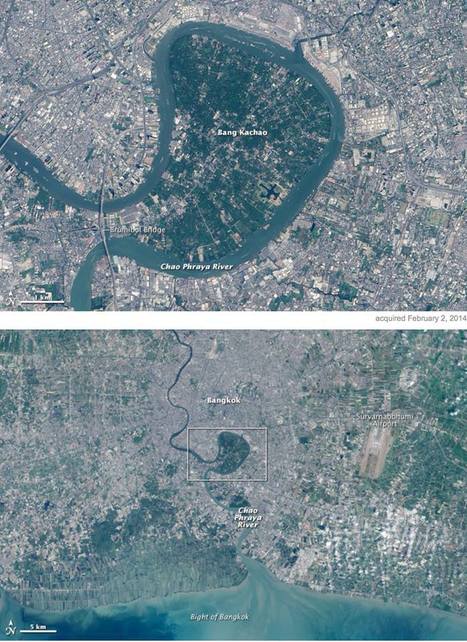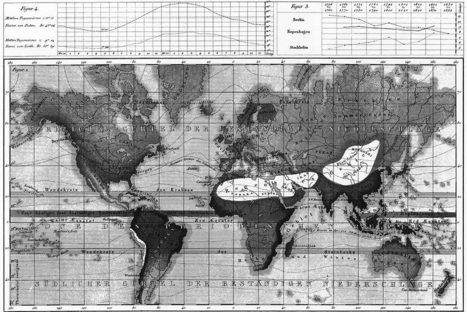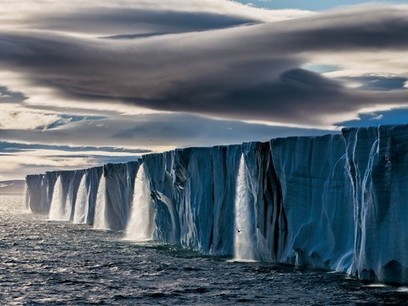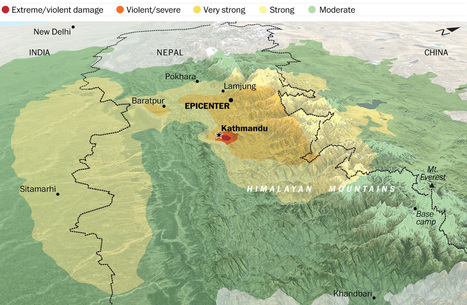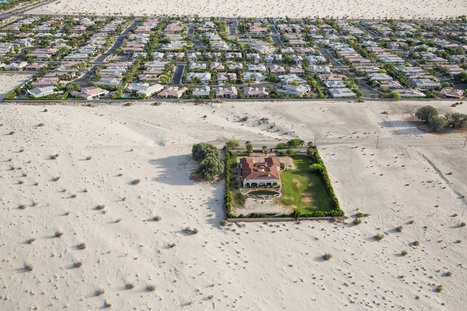Get Started for FREE
Sign up with Facebook Sign up with X
I don't have a Facebook or a X account
 Your new post is loading... Your new post is loading...
 Your new post is loading... Your new post is loading...
Ivan Ius's curator insight,
February 28, 2016 7:03 PM
Geographic Thinking Concepts: Patterns and Trends; Interrelationships;

Maricarmen Husson's curator insight,
January 31, 2016 6:14 PM
.Mientras que el derretimiento del hielo del Ártico se está abriendo de este a oeste , especies de unos 75 animales también podrían hacer el viaje.

Olivia Campanella's curator insight,
September 26, 2018 10:42 AM
This article is about a desert located north of Chile where a barren desert becomes a valley of pink wildflowers. This desert acts like a high pressured trap keeping the low pressure storm out and leaving most parts of the landscape parched with less than 0.2 inches of rain. earlier that year, unexpected clouds started forming leaving the barren land with 2 inches of snow and rain. Enough had fallen to cause an overflow of the banks and rivers to create flooding. But, even though this rain caused flooding it brought the valley "back to life" leaving a seemingly endless carpet of pink wildflowers.

Matt Danielson's curator insight,
September 29, 2018 4:59 PM
The Atacama desert is the nearly never receives rainfall. Every decade or so it does get some rain. When this happens the buried seeds that await the rains germinate and blossom causing a vast landscape of beautiful purple and pink flowers in a normally arid desert. This phenomenon happen recently causing the greatest bloom seen in the Atacama desert in decades. This if anything proves the beauty and resilience of nature, even with nearly no rain in a desert plants still find a way to overcome.

Kelvis Hernandez's curator insight,
September 29, 2018 10:00 PM
Truly amazing. After an intense rainfall, the Atacama desert in Chile was in bloom. The Atacama desert which has been described as the driest place in the world was hit with 2 inches of rain that caused massive flooding throughout the area. While the floods moved the desert and created something beautiful, you can not ignore the fact that they also moved through cities causing some deaths and a billion dollars in damages. Nature can be both beautiful and terrifying.

Maricarmen Husson's curator insight,
September 24, 2015 9:23 PM
Tsunami ocurrido en Chile el 22 de Mayo de 1960 donde murieron 2000 personas en Chile y Perú, 61 en Hilo Hawaii, 142 en Japón causando daños en Islas Marquesas Polinesia , Samoa, Nueva Zelanda, Australia, Filipinas, Alaska's Islas Aleutianas.....enlace para ver la comparación con el Tsunamis recientes en Chile (2015)
Katie Kershaw's curator insight,
February 8, 2018 3:24 PM
The animation in this video depicts how Central America and the Caribbean’s landforms came to be. What is interesting is that about 170 million years ago, Africa and South America were part of the same land mass and today Africa is pretty far away from South America. This means that there are probably similar geographic features on the two continents, like rocks or soil, despite the distance between them now. That may contribute to people being able to grow similar crops in the two areas that are oftentimes seen as so different. The western part of South America, specifically Central America seems to have been pulled apart from North America. This means that these two continents may share geographic features as well. Although regions may seem like they are separated by great lengths and should be dissimilar from each other, that is not the case- as the tectonic plates are constantly shifting the way the earth’s surface looks. It’s hard to think that the earth was ever different than it is today and how such large land masses could possibly move so far. This animation does a good job of exemplifying the great effect that tectonic plates actually have.
Nicole Canova's curator insight,
February 9, 2018 5:36 PM
It's interesting to see how the earth's surface has changed over time. It's also strange to see that at one point the Americas were so compact, and that Africa was attached to both North and South America. Although these tectonic shifts take place over the course of millions of years, this video makes me wonder what the globe will look like in another million years, or another 100 million years. I'm sure the continents will be in a new configuration as unrecognizable as they were 170 million years ago.

Corey Rogers's curator insight,
December 14, 2018 11:24 PM
It is fascinating to see how South and Central America has formed into what we know today. A nice view of what was once attached to Africa is now a distant past and can still see some similarities. It's nice to see how our world today was formed million of years ago.

Chris Costa's curator insight,
November 30, 2015 9:16 AM
Geography determines human activity, and not the other way around; that has been the theme of this course, and it holds true as we look at the devastating impacts of earthquakes in the nation of Nepal. Sitting right over one of the most active plate boundaries in the world, with the Indian subcontinent being violently forced under the rest of Asia, Nepal is therefore the home of both the infamous Himalayan Mountains and numerous earthquakes, varying in severity and frequency. As violent and as costly as they are, violent earthquakes are just another part of life in Nepal, as are other natural events in other parts of the globe, and the people who call it home adjust their lives accordingly, through a variety of means. However, nothing can prepare anyone for the extremes of earth's power, and the violent earthquake that shook the nation to its very core in May has left behind a great deal of human suffering and destruction. I hope that those who lost their homes and businesses are already well along on their path to recovery, although I don't think it's possible to every truly heal from such a traumatic experience, at least not completely.

Richard Aitchison's curator insight,
March 22, 2018 11:09 AM
This is a great example of how using technology can benefit people. In Nepal, in which they are an area where they can get many earthquakes, they used "crisis maps" to their advantage. First off as the article state Nepal is a very difficult country to navigate and especially after the earthquake with roads being destroyed it could make it nearly impossible. With people in dire need of supplies they had to get creative. So here they used a software system called "OpenStreetMap." It is, as described in the article, a Wikipedia for mapmakers. Basically, anyone can add to the map from an amateur to a professional map maker. By allowing everyone to help they were able to make more accurate maps and faster ways to reach someone that had a need for supplies, these became the crisis maps that they would use. Going into the future this software will continue to be important in Nepal as you can constantly edit the maps and continue to find better and more efficient ways to get to place to place. Other countries with these issues should look towards Nepal and take preemptive action so that when a disaster does strike they will be ready and will not lose valuable time right after a disaster. A very interesting article in which I did not previously know much about.

Maricarmen Husson's curator insight,
April 27, 2015 5:52 PM
"Los geocientíficos han dado a conocer un modelo de computadora que asigna los detalles de esa danza tectónico en 1 millón de años incrementos de una recapitulación fotograma a fotograma de tiempo geológico. Esto demuestra que las placas aceleran, frenan, y se mueven alrededor de pequeños estallidos de actividad. también sugiere que los investigadores pueden tener que repensar lo que impulsa gran parte de ese movimiento incesante. El nuevo modelo muestra que, aunque por lo general se arrastran a lo largo de las placas a una velocidad media de unos 4 centímetros por año, algunos pueden alcanzar velocidades mucho más rápidas en carreras cortas. Por ejemplo, la India, que estalló frente a la costa oriental de África a unos 120 millones de años y ahora está arando en Asia, alcanza velocidades de hasta 20 centímetros por año durante un tiempo relativamente breves 10 millones años ".

Melissa Marshall's curator insight,
April 30, 2015 8:17 PM
Interactive that would be great for Year 7 and 8 Science next term - moving through the layers of the Earth!

Savannah Rains's curator insight,
May 27, 2015 1:51 AM
This scoop shows an example of built environmental space. The highly urban and crowded Thailand has little green space. So why is this massive green park looking landmass there? Its a strictly environmental section of land to help water flow into the ocean. The people call it the "green lung" because its plants give off oxygen and provide a contrast from its urban sprawl. This article shows the importance that should be placed on having more strictly environmental places in big cities. 
Chris Costa's curator insight,
November 9, 2015 2:06 PM
It's interesting to see the mixture of natural and manmade landscapes in this image. Humans have an enormous influence on the world around us- we have moved entire rivers for our own purposes, reshaped entire regions. In China, we have literally made it rain. Therefore, it's nice to see remnants of the rich environments that used to cover the urban sprawls of many of the world's largest cities, like Central Park in New York. Bang Kachao in Bangkok is another example of this, a reminder of the richness of the region before it was overwhelmed by the urban development that has characterized Bangkok over the previous century. The oasis serves as a valuable tourist attraction, as Westerners come to enjoy the bike trails and small farming community within Thailand's green lung. Leave it to hipsters to travel halfway across the globe just to enjoy nature within the confines of one of the world's largest cities.
brielle blais's curator insight,
May 3, 2018 3:55 PM
This showcases how important physical geography is. This "green lung" breaks up the high urbanized Bangkok. This helps the environment thrive and helps to cut down of emissions that affect climate change which is a problem in some areas.
|

Tony Hall's curator insight,
October 30, 2015 2:21 AM
This is a very good resource on climate change. Well worth having a look:) 
John Puchein's curator insight,
November 6, 2015 7:30 AM
This site is great to show evidence of climate change. It has various sites with videos and articles. The interactive is organized to answer these main questions: How do we know it’s happening?How do we fix it?How do we live with it?
Sarah Cannon's curator insight,
November 25, 2015 10:15 AM
There is too much talk about helping the climate and environment. All politicians do is talk about cleaning the environment and having less pollution. Even Al Gore is big talk. I've only heard of little change. I want to see a difference. I want to see people actually doing things to help the environment. Enough talk. What should happen is a world wide clean up. Jobs should be created where people should clean in their own community. Its a simple job. Get a trash bag, get off your lazy butts, get out of the house, get a group together (who would be paid by the state) to pick trash up off the streets, beaches, trails in the woods, baseball fields, parks. This isn't hard to do. Not just one person, but if a group of people can come together and be employed by their state to clean their community, at least four days a week. There should also be a group of people, even fisherman to clean the ocean, go out and get what ever trash you can find. Using nets, and if fish are caught, throw them back in the ocean. Also, Trash Island has to be eliminated. It boggles my mind that who ever passed the law on trash being dumped into the ocean an Okay to do. Are you kidding me?? What is wrong with you? Our Earth is dying because of humanity. Also the oil spill that happened in 2012, I believe, I saw a man on the news that created a way to capture the oil floating on the surface of the ocean with a blanket like material, sure it would take a lot of those "blankets" but at least it would be helping to rid the ocean from oil. What are people thinking?? that the oil will just disappear?? Are you serious? So many people really have to open their minds. Look at what's happening you ignorant selfish fools. I will finish my rant right here.

Felipe Rengifo's curator insight,
September 16, 2015 10:49 AM
Censo de árboles está en 3.02 trillones de arboles
Suena como mucho, pero con en realidad son pocos para tanta gente.
David Stiger's curator insight,
September 12, 2018 12:24 PM
Thanks to advancements in technology and dedicated researchers who often forgo glory and fame, Americans are now aware of another impending natural disaster that is likely to ruin the lives of so many of our fellow citizens. This article reminded me of the impending doom of climate change and the resulting ecocide. So many of us, even people who put faith in religion, trust scientific discovery enough to acknowledge that these are realities we face as a society. Not all of us are totally brainwashed to dismiss this a secular, liberal hoax. Despite this awareness, not much - if anything - is being done to address or prepare for the awaiting earthquake and tsunami. This fact affirms that the United States' population is largely out-of-touch with reality. In a fantasy world, like ours, we are too special and superior (perhaps chosen by destiny or God) to suffer such a drastic and radically dreadful experience of nature. The delusion prevents us from acting sooner, rather than later. What comes to mind is the Netherlands as they train their population and renovate their urban centers to flow with the tides of climate change. They have the knowledge (like we do) but the difference is they have embraced it and in a communal way have decided to take action. These Europeans are adapting to their situation. This sheds light on the irony of the United States; a powerful, resource rich, skilled, and highly capable country that is falling a part because of what? Greed for wealth? Selfishness? Dare-I-say foolishness? Maybe it is indifference in an age of modernity - devoid of true human connection but full of technological bliss and distraction? Add the Cascadia subduction zone to modernity's doom list now including unsustainable wealth inequality, overextended military policies, climate change complacency/denial, mass incarceration, obesity, mass shootings, a post-fact world, and an Opioid health epidemic. These are BIG problems that need bold strokes. Simply put, many people with wealth and power do not feel a connection to their countrymen and countrywomen to allow a government - acting on behalf of the masses - to do something. And, that is a key link. Businesses seeking to make a profit do not want regulations and adaptation to interfere. The cost of addressing these problems is a potential loss of money-making as consumers modify their behavior and new policies require more funding through taxes. As this article relates to geography and my aforementioned class-warfare rant: the Earth is indisputably a complex planetary system that has always been totally indifferent to human wants and needs. The planet has no obligation or will to act in our best human interests. We, as a people, must respond to the planet. When it shakes, we must brace or move. In other words, we must take action or experience the consequences of inaction. Crony capitalism, excessive wealth, and a government held hostage by corporate interests which prioritize profit over people are serious hurtles. The wealthy and powerful should realize that they need US - the 90% of people that lack significant amounts of disposable income. 90% is a large chunk of civilization! There is no wealth and prosperity if there is no healthy civilization on which to build a business or exercise entrepreneurial abilities. It is time to confront greed by recognizing our collective humanity - a humanity shaped and informed by geographically determined experiences. 
Kelvis Hernandez's curator insight,
September 29, 2018 7:48 PM
An insightful and honestly, scary article. Discussing the inevitable earthquake that would devastate the pacific northwest, but not knowing when it could occur makes me never want to even visit. The Cascadia earthquake which could or more likely would send a tsunami straight into Oregon. Learning from the Seaside, Oregon superintendent that three of the four schools under his charge will go from five to fifteen feet above sea level to as much as forty-five below would shake anyone to their core. So what has the state done to remedy this? Nothing, unfortunately. With no Early-warning system, he describes how one elementary school will be trapped, as they will have no escape. With the growing ocean waters on one side and a roadless bog on the other, these students have nowhere safe to go. This reminds me of the question, would you rather know how you will die or when you will die? Waiting with no clue when the impending doom will occur until it happens is too much for me. I recommend get out now and get out quick unless the state figures out a warning system, then just get out quick. 
Corey Rogers's curator insight,
December 13, 2018 11:00 PM
Yes, we have some serious earthquakes on the San Andres fault and in Japan but we're overlooking the one along the Pacific Northwest. An out roar has to be made for people to be more notified of the Cascadia subduction zone, so people can prepare for tragedy. We need to realize that the way these plates move can make a major ripple effect on our way of life.

Loreto Vargas's curator insight,
July 2, 2015 10:07 AM
“El Anillo de Fuego” es una cadena de volcanes y lugares de actividad sísmica, o temblores, alrededor de los límites del Océano Pacífico. “L’Anneau de Feu” c’est une chaine de volcans et de sites d’activité sismique, ou tremblements de terre, autour de limites de l’Océan Pacifique.
Katie Kershaw's curator insight,
April 5, 2018 2:34 PM
Not to make a joke of a serious situation, but I almost cannot function when the weather hits 80 degrees and I value air conditioning as much as oxygen sometimes (I am a baby when it comes to heat). So the fact that people in New Delhi and the surrounding areas had to deal with temperatures of 122 degrees makes me cringe and sweat just thinking about it. This article brings up some interesting points about how sometimes the weather can reveal the shortcomings of a society. First of all, the fact that people actually died because of heat says to me that the government was not prepared to deal with this type of crisis. There wasn't adequate resources to give people the necessities of water and shelter when facing such high temperatures. It seems like in this type of heat people probably cannot function as they normally can, so it seems like a system should have been better prepared to keep people indoors and hydrated. Another flaw of the government that is revealed in this type of weather is poor infrastructure. The article says that the electrical grids of cities are being overwhelmed by air conditioning use and wide outages were possible. In an area with a high population and the potential of facing such extreme weather, there should be more of a priority placed on repairing and maintaining electrical grids and wiring. The high heat also exposed that the roads weren't built to sustain this weather because it literally started melting. This unfortunate incident in India shows that humans can control a lot these days, but the weather is still untouchable. The best way to deal with extreme weather is to be better prepared to face it.

Zavier Lineberger's curator insight,
April 24, 2018 1:31 PM
(South Asia) India, with the second largest population in the world and a developing infrastructure, often faces heatwaves due to its climate. But recently the heat, spurred by climate change, led to hundreds of deaths. There is no doubt that there are more deaths than can be reported due to the country's largely isolated and rural populations. In this article from 2015, the temperature reached 122 Fahrenheit. The heat causes numerous urban problems, such as power outages due to ACs and melting roads, but most deaths typically happen in poorer areas.
brielle blais's curator insight,
May 1, 2018 6:50 PM
India is facing a change in their physical geography as climate change continues to prove itself to be a real problem. The amount of energy being used to air condition homes is astounding and the government is worried of massive power outages. "India's power industry has long struggled to meet rapidly rising demand in Asia's third largest economy, with poorly maintained transmission lines and overloaded grids." Physical geography can effect the economy as well.

Joshua Mason's curator insight,
April 29, 2015 11:04 AM
It's absolutely devastating what happened to Nepal. Any loss of life is a tragedy but loss of this scale is unimaginable. It's going to be a difficult rebuilding process for the Nepalese whether that's coping with the loss or physically rebuilding the nation.
Watching footage of shakes, what struck me the most was hundreds of year old temples crumbling. Those just aren't something you can easily rebuild. The building can eventually be replaced but the significance of it is almost lost.
Those temples, like the homes in the area, were most likely not built up to a standard that could withstand earthquakes or at least earthquakes of this magnitude. It's easy to see how destruction on this scale can occur in large urban populations that were not designed to stand against such a dramatic event. 
Kristin Mandsager San Bento's curator insight,
May 1, 2015 3:59 PM
I've experienced earthquakes more times than I've ever felt the need. We used to get them all the time it seemed in Japan. My bed would role across the room. It got to the point where I just slept through them. If I had even felt a shake half as violent as what Nepal went through I could not even imagine the fright. I wonder how long the India and Eurasia tectonic plates will stay on top of each other? Or if a few more earth quakes will split the area? 
GTANSW & ACT's curator insight,
June 1, 2015 1:52 AM
Australian Curriculum The causes, impacts and responses to a geomorphological hazard (ACHGK053) GeoWorld 8 Chapter 4: Hazards: causes, impacts and responses (4.5 - 4.6 Earthquakes)
Gene Gagne's curator insight,
November 18, 2015 12:48 PM
We have learned that the Himalayas are growing everyday while our Appalachians in the united states are shrinking. What does this all mean? In the platonic spectrum it means in Nepal, earthquakes. |














